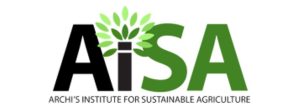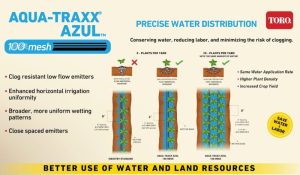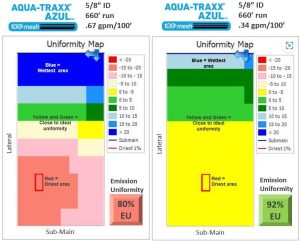The drip irrigation system must be monitored and operated. It cannot be stressed enough how important the first two categories (flow meters and pressure gauges) are to assess performance and guidance for operation, and how important the last two categories (valves and controllers) are to deriving the maximum benefit from a drip irrigation system.
 System Flow Meters
System Flow Meters
System Flow Meters are available in a range of sizes and types, and commonly provide both instantaneous and cumulative water flow with an accuracy of approximately two percent. Flow meters may also be fitted with electrical analog conversion units that are capable of transmitting flow rate data to a centralized irrigation control computer. A micro-irrigation system offers the user an unprecedented degree of control over his water and power costs, and over the growing conditions of his crop. To take full advantage of this ability to control the irrigation system, it is necessary to have useful feedback information on flow rates and total water applied during a given time period. Accurate flow rate information is also indispensable for the analysis of crop response to water and nutrients, and for monitoring the continuing performance of the irrigation equipment system. A good quality system flow meter is therefore an essential part of a well designed micro-irrigation system.
 Pressure Gauges
Pressure Gauges
Pressure Gauges are an essential item for drip systems since visual monitoring is often impractical or impossible. Pressure gauges placed at the pump station, before and after the filter station, and upstream and downstream of each control valve will provide an immediate indication of system performance. If pressures are too low, a leak could be indicated, a filter plugged or a valve jammed. If pressure are too high, the system could be plugged or a valve may be set incorrectly. Similar to a flow meter, accurate pressure information is essential part of a well designed and operated drip system.
 Control Valves
Control Valves
Control Valves are used to control the flow of water to the various blocks or network zones. They may be simple manually operated valves, or fully automated solenoid activated on/off or pressure reducing valves. They may be co-located at the pump station or other Point of Connection (POC), or may be dispersed throughout the farm or landscape.
 Irrigation Controllers
Irrigation Controllers
Irrigation Controllers are used to automatically start and stop irrigation events by sending electronic current to solenoid activated valves. The electronic current is controlled by a user defined schedule that is entered for each zone control valve. More sophisticated controllers may allow automatic adjustment of the program based on sensor inputs such as weather (plant water use or rain), system flow or system pressure.




